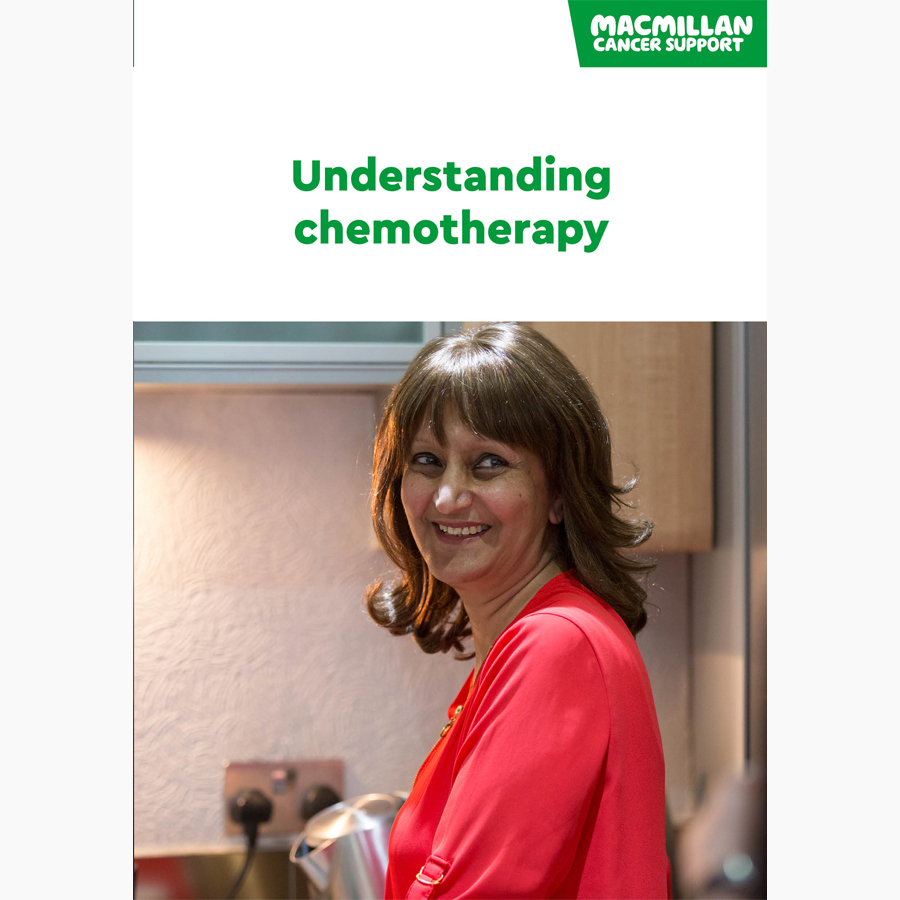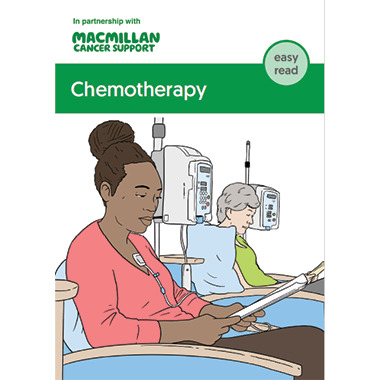Chemotherapy for a brain tumour
Chemotherapy uses anti-cancer drugs to treat brain tumours. It may be given with or after radiotherapy, or after surgery. It may also be given as a treatment on its own.
What is chemotherapy?
Chemotherapy uses anti-cancer drugs to destroy cancer cells. These drugs affect the way cancer cells grow and divide, but they also affect normal cells.
Booklets and resources
Chemotherapy for brain tumours
Chemotherapy for brain tumours may be given:
- at the same time as radiotherapy – this is called concurrent treatment
- after radiotherapy or surgery – this is called adjuvant treatment
- as your main treatment
- if a brain tumour comes back.
Chemotherapy is usually the main treatment for a lymphoma that starts in the brain (primary CNS lymphoma or PCNSL).
When is chemotherapy used?
Your doctor will tell you if chemotherapy might be helpful for you. Side effects of drugs may vary. Your doctor will talk to you about the risks, benefits and side effects of having chemotherapy. If you decide to have chemotherapy, your treatment team will explain the side effects and give you a chance to ask questions.
Having chemotherapy may depend on:
- the type, grade and biomarkers of a tumour
- how effective other treatments have been
- your general health and fitness.
During chemotherapy, your doctor and nurse will check how you are. You will have follow-up brain scans to check whether treatment is working.
Getting support
Macmillan is here to support you. If you would like to talk, you can:
- Call the Macmillan Support Line for free on 0808 808 00 00.
- Chat to our specialists online.
- Visit our chemotherapy forum to talk with people who have had chemotherapy, share your experience, and ask an expert your questions.
Chemotherapy drugs
The main drugs used to treat primary brain tumours are:
- temozolomide
- CCNU, also called lomustine
- procarbazine
- vincristine.
You may have 1 drug, or you may have a combination of drugs.
When CCNU, procarbazine and vincristine are given together, the combination is called PCV. Or you may only have 1 or 2 of those drugs. Your doctor will explain which chemotherapy drugs you may have.
Other drugs may also be used if you have a rarer type of brain tumour.
How chemotherapy is given
There are different ways of giving chemotherapy for brain tumours.
Chemotherapy on its own
Temozolomide, lomustine and procarbazine are capsules you swallow. Vincristine is a liquid that is given into a vein (intravenously).
You usually take chemotherapy capsules at home. Your doctor, nurse or pharmacist will tell you how and when to take them. You may be asked to take them for a certain number of days or weeks, with a rest period of a few weeks.
Intravenous chemotherapy is given in a chemotherapy day unit. A chemotherapy nurse will give it to you as 1 or more sessions of treatment. You usually have a rest period of a few weeks between each session.
Each session of chemotherapy is called a cycle. The length of the cycle depends on the chemotherapy drug. The number of cycles you have will depend on your tumour type and your individual situation.
For example, PCV is given for 10 days every 6 weeks. Temozolomide capsules are usually taken for 5 days every 4 weeks.
Rarely, a chemotherapy drug called carmustine is given as an implant called Gliadel wafers. This is put directly into the brain during surgery.
Your doctor, nurse or pharmacist will explain what chemotherapy you might have and what to expect.
Chemotherapy with radiotherapy
If you have a high-grade glioma (glioblastoma), you may have temozolomide and radiotherapy together. This means you take temozolomide capsules every day during your course of radiotherapy. The radiotherapy usually lasts 3 to 6 weeks.
Having both treatments may cause more side effects, so you need to be physically well enough to cope. You also have more risk of getting a chest infection. To help with this, your doctor will prescribe antibiotics.
When you finish radiotherapy, you will also stop taking temozolomide for a time. You then start taking temozolomide again for up to 6 cycles. You usually take it for 5 days every 4 weeks. Your doctor or nurse will explain how often you need to take it.
Side effects of chemotherapy for brain tumours
Chemotherapy can cause side effects. These can often be managed or controlled with drugs. Side effects usually gradually improve after treatment has finished. Different drugs cause different side effects. Your doctor, nurse or pharmacist will explain what to expect.
We have more information about the side effects of chemotherapy.
About our information
This information has been written, revised and edited by Macmillan Cancer Support’s Cancer Information Development team. It has been reviewed by expert medical and health professionals and people living with cancer.
-
References
Below is a sample of the sources used in our primary brain tumour information. If you would like more information about the sources we use, please contact us at informationproductionteam@macmillan.org.uk
EANO-ESMO Clinical Practice Guidelines for prophylaxis, diagnosis, treatment and follow-up: Neurological and vascular complications of primary and secondary brain tumours. 2021. Available from www.eano.eu/publications/eano-guidelines/eano-esmo-clinical-practice-guidelines-for-prophylaxis-diagnosis-treatment-and-follow-up-neurological-and-vascular-complications-of-primary-and-secondary-brain-tumours [accessed August 2024].
NICE Guideline NG99. Brain tumours (primary) and brain metastases in over 16s. 2018 (updated 2021). Available from: www.nice.org.uk/guidance/ng99 [accessed August 2024].
Date reviewed

Our cancer information meets the PIF TICK quality mark.
This means it is easy to use, up-to-date and based on the latest evidence. Learn more about how we produce our information.
The language we use
We want everyone affected by cancer to feel our information is written for them.
We want our information to be as clear as possible. To do this, we try to:
- use plain English
- explain medical words
- use short sentences
- use illustrations to explain text
- structure the information clearly
- make sure important points are clear.
We use gender-inclusive language and talk to our readers as ‘you’ so that everyone feels included. Where clinically necessary we use the terms ‘men’ and ‘women’ or ‘male’ and ‘female’. For example, we do so when talking about parts of the body or mentioning statistics or research about who is affected.
You can read more about how we produce our information here.
How we can help






